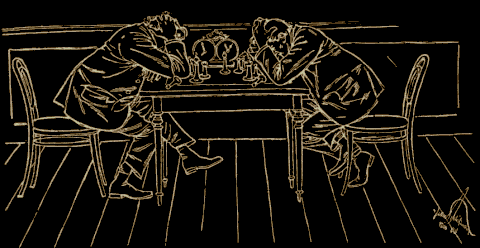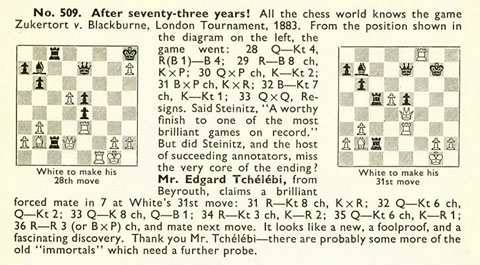



FIVE:

White to move. ‘This position received some well-merited attention
in 1957.
As ever, it is the fastest line that needs to be found.’
The position arose after Black’s 30th move in Zukertort v Blackburne, London, 1883, one of the most famous games. Zukertort won with 31 Bxe5+, a move attributed two exclamation marks by Fred Reinfeld on page 34 of The Chess Masters on Winning Chess (New York, 1960). As related in C.N. 2193, however, a forced mate in seven with 31 Rg8+ had already been put forward by Edgard Tchélébi of Beirut (1928-1963) on page 60 of the March 1957 BCM (in D.J. Morgan’s Quotes and Queries column):

In algebraic notation: 31 Rg8+ Kxg8 32 Qg6+ Qg7 33 Qe8+ Qf8 34 Rg3+ Kh7 35 Qg6+ Kh8 36 Rh3+ (or 36 Bxe5+) and mate next move.
SIX:

Black to move. ‘The question here is whether there is
more than one way for Black to win, just one way, or no way at all.’
We took the position (see C.N.s 2713 and 2735) from page 29 of the 27 June 1908 issue of the Chess Weekly:

The solution appeared on page 72 of the 1 August 1908 issue:

Thus the magazine noted that 1…Bh2 2 Rxd2+ Kxd2 3 Kb2 Ke3 4 Kxb3 Kf4 5 Kc2 Kg5 6 Kd2 Kxh5 7 Ke2 Kg4 8 Kf2 Kh3 wins. In addition, it gave the line 1…Ba1, after which 2 Rh1 2 Bd4 3 Rd1 Ba7 4 Rxd2+ Kxd2, etc. also wins. However, after 1...Ba1 White has the better defence 2 Rg1, when Black’s only way to win is 2...Bd4 3 Rh1 Be5 4 Rd1 Bh2, transposing into the main line given above.
So, how many winning moves does Black have? He can win by playing both 1...Bh2 and 1...Ba1. Nonetheless, against the best defence 1...Ba1 has only the virtue of not spoiling the win. It could thus be argued that there are two winning moves, but only one that forces the win (1...Bh2).
We are grateful to Yasser Seirawan, who, having examined this position closely, summarizes matters as follows:
‘One win (1...Bh2) or two (1...Bh2 and 1...Ba1) in this position? If I have a checkmate but, first, I repeat moves (gaining time on the clock) before proceeding with the win, it is indeed true that I did not choose between “two different ways to win”. But if I make an “indirect” move, inviting my opponent to transpose into the checkmate variation or to allow a different checkmate, are there two wins or one? A tough question.
A “different” win is demonstrable after 1...Ba1 in case of 2 Rh1, but after 2 Rg1 the same win is available for Black as would have occurred if he had played 1...Bh2. So in one case 1...Ba1 can lead to a separate and “independent” win (albeit slower than the win with 1...Bh2), and in the other case 1...Ba1 leads to moves being repeated.
So, one win or two? It is an interesting conundrum.’
SEVEN:

White to move. ‘This is the oldest position in the present set,
and one of eight games played in a blindfold simultaneous exhibition.’
James A. Leonard (blindfold) – Hoffman
New York, 11 December 1861
Centre Game
1 e4 e5 2 d4 exd4 3 Nf3 Bc5 4 Bc4 Qf6 5 O-O h6 6 c3 Nc6 7 e5 Qg6 8 cxd4 Bb6 9 d5 Nb4 10 a3 Na6 11 Nc3 Ne7 12 Nh4 Qh7 13 d6 g5 14 dxe7 gxh4 15 Nd5 Qg6 16 Be3 c5 17 f4 Rg8 18 Qf3 Nc7 19 f5 Qg7 20 Nf6+ Kxe7 21 Nxg8+ Qxg8 22 Bxh6 Ne8 23 Qh5 d6 24 Qxh4+ Kd7 25 Rad1 Kc7 26 f6 Bd7 27 Bf4 Bc6 28 exd6+ Kd8 29 Qg5 Qh7 30 Rfe1 Qc2 (Reaching the diagrammed position).
Leonard announced a forced mate in five beginning with 31 d7. For example, 31...Qxd1 32 dxe8(Q)+ Bxe8 33 Rxd1+ Kc8 34 Qf5+ Bd7 35 Qxd7 mate. If 31...Bxd7 32 Rxe8+ Kxe8 33 Qg8 mate.

James A. Leonard
The game is included in our feature article James A. Leonard and also appears on pages 165-166 of The Tragic Life and Short Chess Career of James A. Leonard, 1841-1862 by John S. Hilbert (Jefferson, 2006). Dr Hilbert’s source for the game-score was the New York Clipper of 4 January 1862.
EIGHT:

White to move. ‘Is Black as helpless as he looks?’
This position occurred in a game between Rudolf Loman and Oscar Müller in London, 1897. Black is indeed helpless. Loman played: 1 Qh6+ Ke5 2 Qe6+ Kd4 3 Qd5+ Ke3 4 Qd3+ Kf2 5 Qf1+ Kg3 (or 5...Ke3 6 Qg1+ Kxf3 7 Be2 mate) 6 Ne2+ Kh4 7 Qh1+ Kg5 8 Qh5+ Kf6

Now there is a single difference, but a vital one: the white knight controls d4. The game ended: 9 Qh6+ Ke5 10 Qe6 mate.
Source: Deutsches Wochenschach, 11 July 1897, page 227.

Rudolf Loman
Announcement of the winners

The entrant whose name the World Champion has inscribed in Vishy Anand: My Best Games of Chess (Gambit Publications Ltd., 2001) is Dennis Monokroussos (South Bend, IN, USA).

Anand signing his book and copies of Fritz 11 in the ChessBase office in
Hamburg on June 6th 2008
In addition, two entrants have been picked at random as winners of a consolation prize (Fritz 11, signed by the World Champion). They are Daniel Brandão (Florianópolis, Brazil) and Hans-Joachim Schrader (Hanau, Germany).
Submit information or suggestions on chess explorations
 Edward
Winter is the editor of Chess
Notes, which was founded in January 1982 as "a forum for aficionados
to discuss all matters relating to the Royal Pastime". Since then over
5,600 items have been published, and the series has resulted in four books by
Winter: Chess
Explorations (1996), Kings,
Commoners and Knaves (1999), A
Chess Omnibus (2003) and Chess
Facts and Fables (2006). He is also the author of a monograph
on Capablanca (1989).
Edward
Winter is the editor of Chess
Notes, which was founded in January 1982 as "a forum for aficionados
to discuss all matters relating to the Royal Pastime". Since then over
5,600 items have been published, and the series has resulted in four books by
Winter: Chess
Explorations (1996), Kings,
Commoners and Knaves (1999), A
Chess Omnibus (2003) and Chess
Facts and Fables (2006). He is also the author of a monograph
on Capablanca (1989).
Chess Notes is well known for its historical research, and anyone browsing in its archives will find a wealth of unknown games, accounts of historical mysteries, quotes and quips, and other material of every kind imaginable. Correspondents from around the world contribute items, and they include not only "ordinary readers" but also some eminent historians – and, indeed, some eminent masters. Chess Notes is located at the Chess History Center. Signed copies of Edward Winter's publications are currently available.